DUBAI: The Riyadh-born, New York-based contemporary artist Sultan bin Fahad has been creating artworks since childhood. But, he says, he didn’t know that’s what he was doing for a long time.
“I always felt like I had a certain creativity in me,” he tells Arab News. “I was making what I called ‘things.’ But it was a hobby, you know? I thought it was like interior design — decorating my room. I didn’t know it could be considered art.”
At the time, bin Fahad was focused on building a career in the navy and on taekwondo. He had realistic hopes of competing in the 1992 Olympics in Barcelona, he says. But a series of injuries put paid to both of those dreams, and left him wondering what to do next.
He ended up studying business in San Francisco, where his accommodation was close to an art academy.
“I’d pass by and see their work; that was the first time I was exposed to modern and contemporary art. And I realized, ‘Oh. So whatever I’ve been doing is probably considered some sort of art.’” He laughs. “That’s how I became aware of my ability to create artworks.”
He has become known particularly for his intricate and colorful beaded works, often created by artisans from the Hausa tribe in Nigeria.
“They have an interesting story,” he says. “They are Muslims, they study the Qur’an. But they kept the language of their tribe. They know all about Saudi. You can actually find descendants of the same tribe in Jeddah and Makkah. Back in the day, they travelled or went for Hajj and they never left. They stayed there for three or four generations.”
Beyond the physical side of his work, however, he says the most important thing is that each piece tells a story.
“I always say my medium is storytelling. I hate it when you show someone something and they say, ‘OK, what am I looking at?’ That means you definitely failed to show any emotion in your work. Like, I still make abstract paintings, and there is basically nothing to say about them. But people forget that there is an emotion when you look at something: you might feel happy, you might feel sad, you might be attracted to the colors. But if you look at any piece and you don’t get any idea in the first 10 seconds, then I failed.”
Here, bin Fahad talks us through some of his most significant works.
‘Delights III’
This series, “Delights,” came about during COVID lockdowns. I collect a lot of found objects, because they inspire me. I’d found these small gift boxes that used to have candy or nuts in. They come with different phrases on them, like, “May your day be filled with happiness and joy.” And there’s always a picture of shaking hands. The handshake is a universal gesture. And during COVID, we didn’t have that. People didn’t shake hands. Some people didn’t even see anyone. It was a dark time. So I thought, “OK, what if we had something in people’s homes, to give joy and a little hope?” First of all, I did a series of beaded works, and they were shown in an online art fair. Then this friend of mine who is a carpet maker had the idea of making carpets designed by artists from the GCC. And they chose me to represent Saudi. So, I designed this carpet. It’s this whole concept of hopeful, beautiful work that you can see every day and can give you good energy. It’s not an artwork; it’s part of the house. It’s living with you.
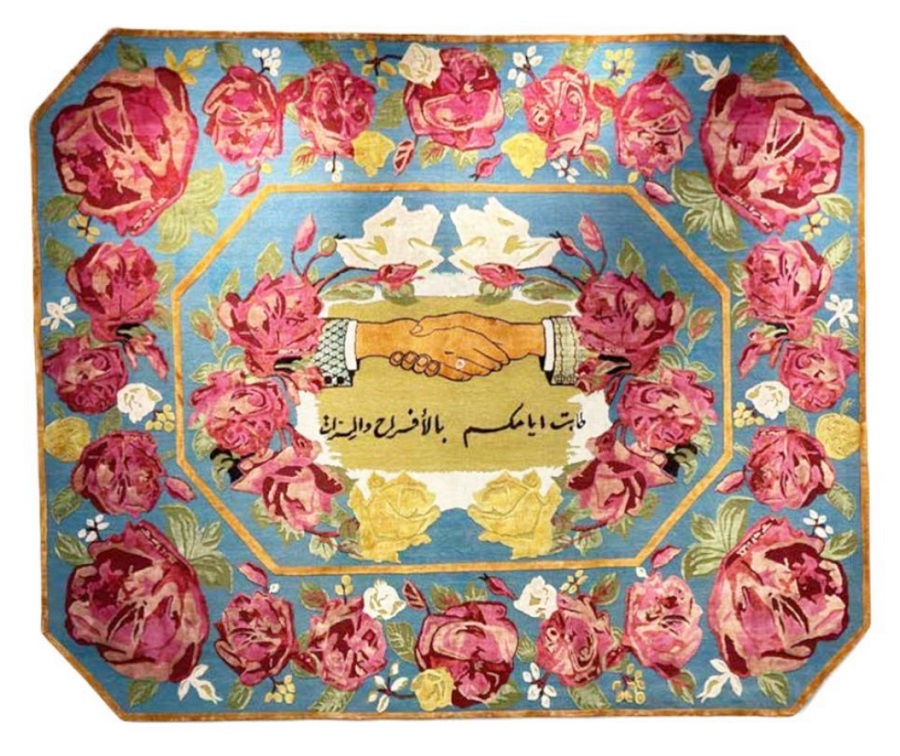
‘Delights III’
‘Desert Kite’
This was created for Desert X AlUla. AlUla is so beautiful. You can’t compete with it. So I wanted something that would basically separate you from the environment; something with walls, so you don’t know what’s around you and you can basically listen to the environment — to silence.
I have this fascination with history and heritage. There are these very interesting structures around the north west of Saudi and the south of Jordan: desert kites. The first time they discovered them was, I think, during World War Two. They were flying over them. You only can see them from above. And I wondered what their purpose was. Some people say that they’re prehistoric animal traps from thousands of years ago, so my intention was to create something telling that story, so that little blue-green object inside? That’s like the bait — food or water. That makes the animal go inside. Then they’re trapped. And inside the sculpture (on the walls) are a lot of mythical animals: the Medusa, the eagle, the Sphinx — and they’re all trapped in there too. And inside you can sit and actually listen to silence, which is very unusual in a place that is open like that. It’s very interesting.
One thing I really liked with this work was people’s interpretation of it. A lot of people said it looked like a keyhole — so it was the key to another culture or civilization; or it was the key between the sky and the Earth. I liked how people became their own curator. I’m happy to have people interpret my work the way they see it — as long as they get something out of it.
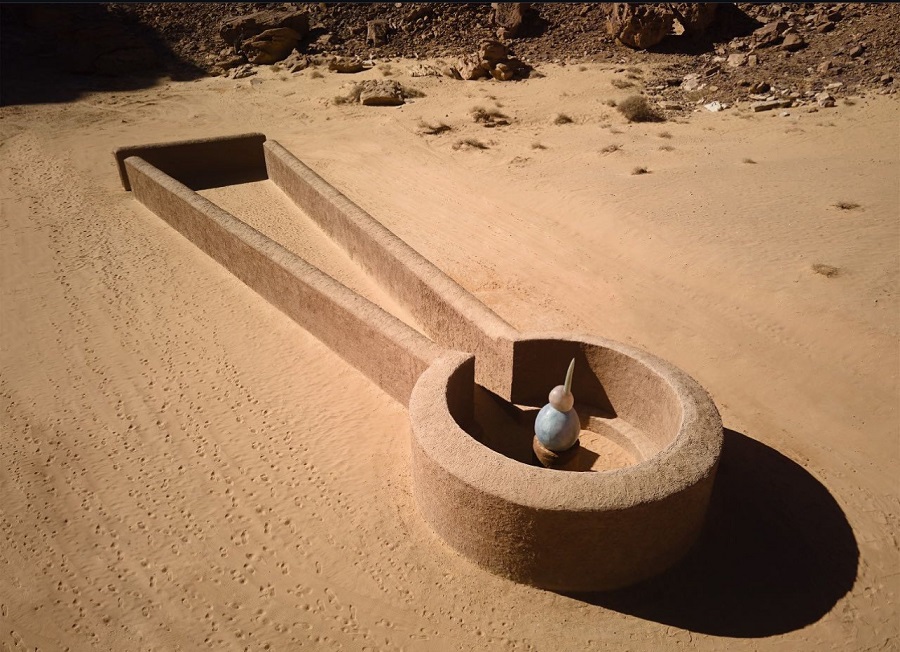
‘Delights III’
‘Window’
This was for my project “The Red Palace.” It’s one of my dearest projects. It made me comfortable with what I’m doing. This was my first real installation work, and my first time really doing something conceptual — almost like theater. And it was my first project with the Hausa artisans. And it’s dear to me because it’s a building I was really inspired by — I always used to walk past it as a kid and I always loved it. It defined architecture in Riyadh and it’s central to the history of Saudi Arabia, whether as a royal palace or as a government building. Everything from the Forties or Fifties to the Nineties was run from that palace.
The whole idea started with Diriyah Season. They wanted to do an exhibition, and I had this idea of doing a performance called “The Royal Dinner.” During that time, King Saud had three chefs, and they’d have a set menu. People think that, in Saudi Arabia at that time, it was all Bedouin. But no, we had sophistication. But nobody talks about it, and it’s not in in books. So I wanted to recreate this royal banquet to celebrate those behind the scenes; the labor that people don’t know about. I submitted this idea to the Ministry of Culture, and they approved it. So then I went and visited the palace, and I was like, “OK, this is much bigger than my idea, why don’t we expand it?” So we did a lot more, including “Window,” which has actually now been acquired by the Guggenheim Abu Dhabi. It’s another dear work to me, because each window was reclaimed from a region of the Kingdom. And it’s backlit, so it shows you how beautiful it would feel to be in those houses with those windows. And it unifies all the regions into one. Like a lot of my work, it’s also nostalgic. When you see those windows, you think back: “Oh, I remember the time when we were kids and playing here and there.”
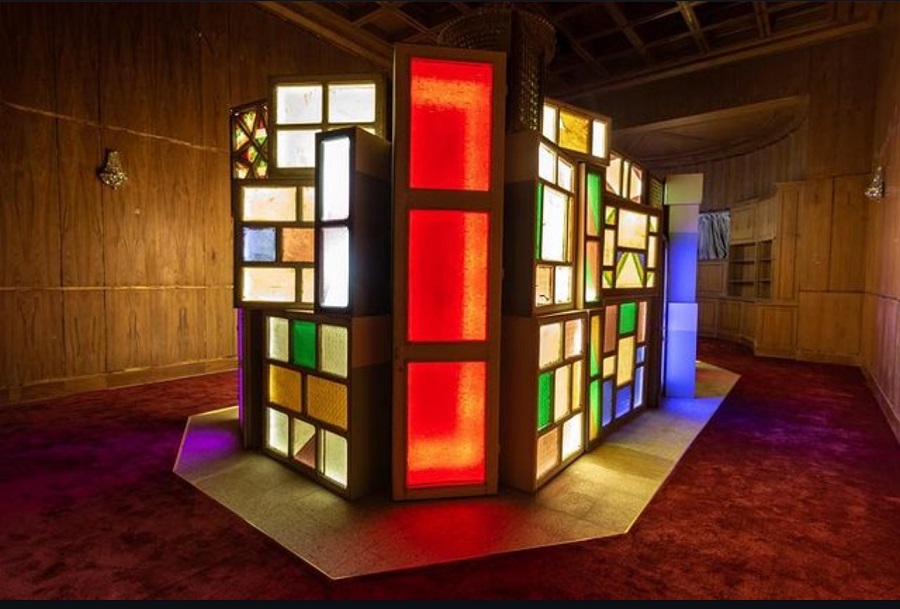
‘Window’
‘Trust’
These chairs were thrones for my “Red Palace” project. When I was looking into doing some beaded work — I wanted to do something in Africa, generally — I didn’t know how to get a contact. I saw I had an Instagram follower from Nigeria. I had no idea who she was. I just DM’d her, and asked if she knew anyone who could make beading work in Nigeria. She said she didn’t, but she could look into it. And she found someone. I showed them what I wanted to do — this was for “The Red Palace” — and while I was doing that, she messaged me and said: ‘Can I ask you a question? Why did you trust me to do this?’ I said, ‘Well, if you want something done, you have to trust someone.” Otherwise I’d have to have travelled myself, you know? When I told the curator this story, she said, “We have to call that piece ‘Trust.’” Because that’s what it was based on. This collaborative work we did, with workmanship like this, they don’t know how to create something new; they just work on what they know — they bead chairs traditionally. I needed to see if they could do it the way I wanted it to be. But that first collaboration led to a lot of other pieces, because they were open to the idea of doing it in a different form. That’s where the trust came from.
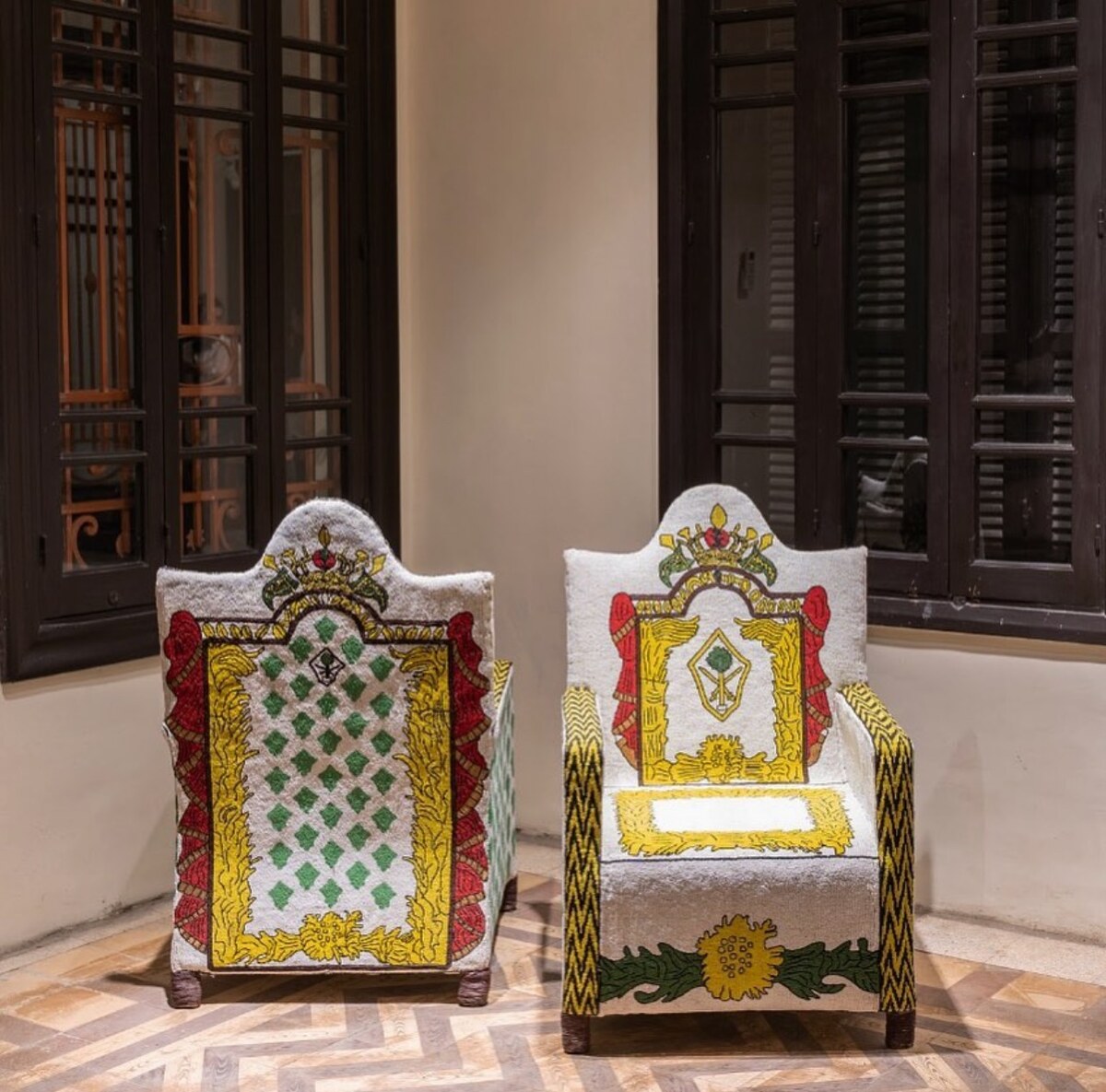
'Trust'
‘Masallaci’
This work is very dear to me. It’s a giving-back-to-the-community work. It’s a beautiful story. During the time when I was doing “The Red Palace” and “Trust,” the Hausa people that were working with me, they work in a village next to Abuja in Nigeria. When they have work, they travel there from their villages and they rent part of the place they’re working in for accommodation. I asked them where they prayed. It kind of made me feel like responsible, like I needed to support the community that was working for me. So, I asked them to decorate part of the place they were working in as a mosque — in their own way, their own traditions, their own language; the writing you see is the Hausa language, not Arabic — in exchange for me renting the space for them, to pray and live and work, for a whole year. Everything inside the mosque is beaded, except the floor. Even the furniture. And they sent a turban for me — you can see it in the picture, a little white turban. The imam of the mosque in Nigeria wears this turban, so this was their gift for me. It’s one of my favorite works. And it was really a collaboration; they designed it themselves, I just gave them the idea.
‘Laser’
This project was called “GWPOW” — which stands for Gulf War Prisoners of War. It’s about the Gulf War, but it’s also relevant to what’s happening now in Gaza. It’s about how life is stolen from kids who become soldiers when they’re supposed to be playing and living. They don’t take the decision, somebody else does.
I was 19 during the first Gulf War. I wanted to volunteer but I couldn’t, because of my injuries — I’d just had my second knee surgery. So I ended up volunteering as a translator. I went and saw the prisoners of war. Some of them were younger than me. They were, like, 16. They didn’t know what they were fighting for. They were just pushed into the war.
So this project was about the war, but it’s also thinking about those kids. They were supposed to be playing, not fighting. So I was thinking, ‘How can I portray those kids living during that time, in the desert, waiting to fight or to be killed?’ So this project became, like, a playroom for grownups. A recreation center in a war zone — everything is kind of childish. This is one of maybe six paintings I did as part of it, along with beaded works. It’s a pencil drawing, but there’s some collage on it, and some abstract painting, and some ink, so it’s mixed media. So the guy holding the lightsaber, that helmet looks like Darth Vader, but it’s not. It’s the helmet of Saddam Hussein’s Fedayeen corps. And I imagined these kids thinking of being a superhero.
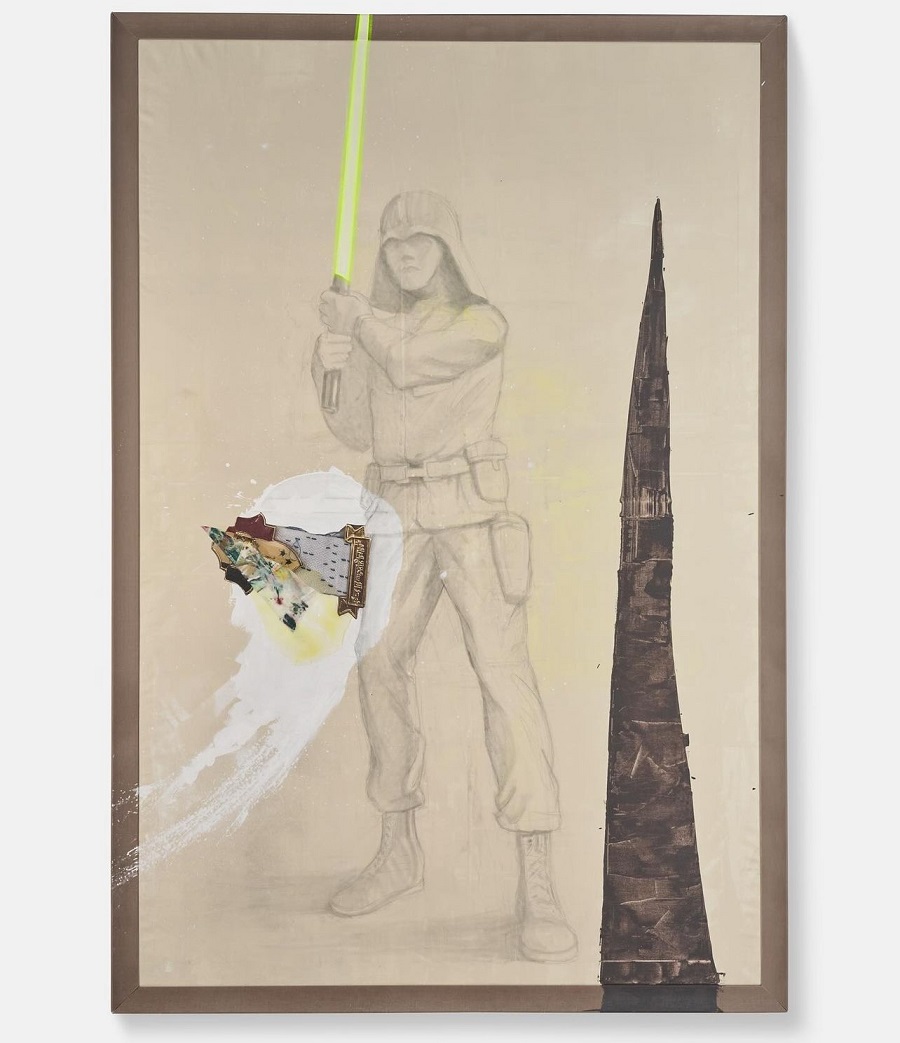
'Laser'
‘Possession’
I saw these people at the Prophet’s Mosque in Madinah. At certain times they open it for women, and they allow people to go privately. I was there with my mom and my family and there were screens, and there were these ladies touching the screens. And to me, it felt like, for them, they were in the highest stage of being possessed by religion, in a good way. Feeling invulnerable. They felt like they are connecting with the Prophet. I mean, I don’t know what it meant to them. I don’t know why they were doing it, but it felt so passionate. And it touched me. I felt like, if it gives them satisfaction, let them do it. It felt surreal to me — but I felt their passion.
‘Once Was A Ruler’
This is a combination of different antiquities that were in the National Museum. I was working there at the time. I wanted to talk about something that is taboo. A lot of people think that these pieces are statues of gods. That’s why they’re hidden away. But at that time, these civilizations were not making big sculptures of their gods, they were making them of themselves. They were a sign of power. So I made it look like an X-ray, and I put human bones on it to show that they are human. They were once a ruler, yes, but a person, not a god.

‘Once Was A Ruler’
‘R III’
“R III” means Ramses the Third. I did this in Egypt, at the Pyramids of Giza. Like with AlUla, this is a place I am in awe of. Like, I can’t compete with nature or with history, so I tried to work with it, complementing the place without actually trying to put my force or my creative energy in it. I was humbled in these places. So, I can’t compete with the Pyramids, but I tried to make something inspired by them. When you look at it from above, you see it has the seal of Ramses the Third. That seal has been found near AlUla, and that means he was probably there — not for fighting, but probably exploring, looking for copper or something — because the pharaohs wouldn’t usually let their seals be carried by others. So I wanted to show this bridge between Ancient Egypt and Saudi Arabia.




















